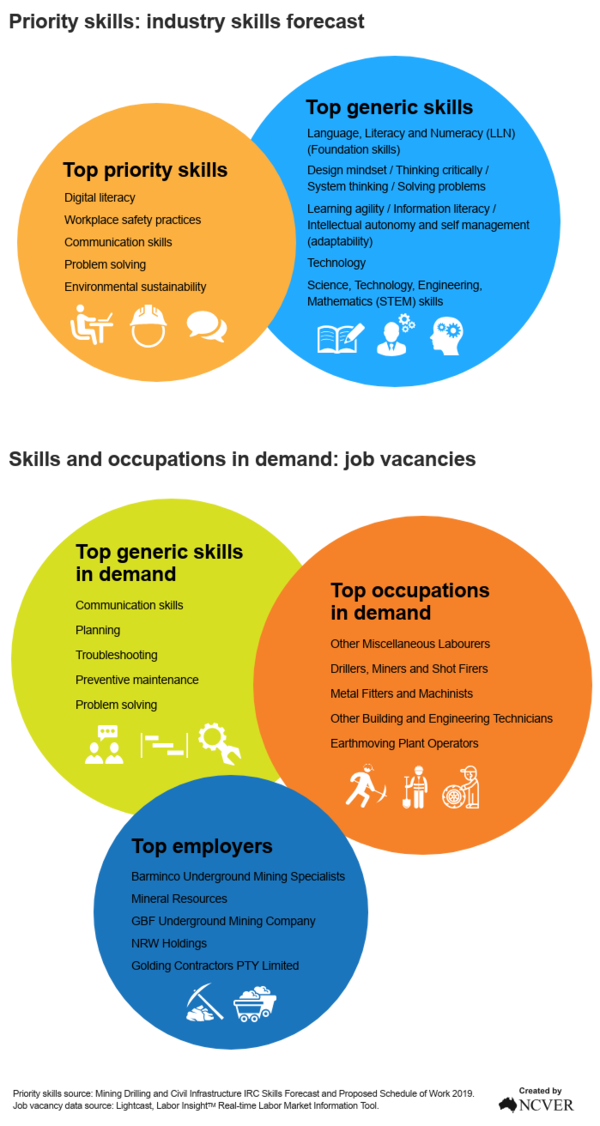Department of Employment 2021, Industry Employment Projections viewed 1 August 2021, Labour Market Information Portal
- by ANZSIC 3 digit industry, employment projections to May 2025
- 101 Exploration
- 109 Other Mining Support Services.
National Skills Commission 2022, Occupation Employment Projections viewed 10 August 2022, https://www.nationalskillscommission.gov.au/topics/employment-projections
- by ANZSCO, selected 4 digit occupations, employment projections to May 2026
- 7122 Drillers, Miners and Shot Firers
- 3232 Metal Fitters and Machinists
- 8219 Other Construction and Mining Labourers.
Australian Bureau of Statistics 2021, 6291.0.55.001 - EQ06 - Employed persons by Industry group of main job (ANZSIC), Sex, State and Territory, November 1984 onwards viewed 1 August 2022. https://www.abs.gov.au/statistics/labour/employment-and-unemployment/labour-force-australia-detailed/may-2022
- Employed total by ANZSIC 3 digit '101 Exploration' and '109 Other Mining Support Services', 2002 to 2022, May Quarter.
Australian Bureau of Statistics 2017, 2016 Census – employment, income and unpaid work, TableBuilder. Findings based on use of ABS TableBuilder data.
- Employment level by:
- 10 Exploration and Other Mining Support Services
- 4 digit level occupations to identify the relevant VET-related occupations in the industry as a proportion of the total workforce.
Training data has been extracted from the National VET Provider Collection, Total VET Students and Courses from the following training package or qualifications:
RII Resources and Infrastructure Industry Training Package:
- Drilling Oil/Gas (On shore)
- RII21109 - Certificate II in Drilling Oil/Gas (On shore)
- RII21113 - Certificate II in Drilling Oil/Gas (On shore)
- RII21115 - Certificate II in Drilling Oil/Gas (On shore)
- RII21120 – Certificate II in Oil & Gas Drilling (Onshore) and Well Servicing
- RII32009 - Certificate III in Drilling Oil/Gas (On shore)
- RII32013 - Certificate III in Drilling Oil/Gas (On shore)
- RII32015 - Certificate III in Drilling Oil/Gas (On shore)
- RII32018 - Certificate III in Drilling Oil/Gas (Onshore)
- RII32020 – Certificate III in Drilling Oil & Gas (Onshore)
- RII41109 - Certificate IV in Drilling Oil/Gas (On shore)
- RII41113 - Certificate IV in Drilling Oil & Gas (On shore)
- RII41115 - Certificate IV in Drilling Oil & Gas (On shore)
- RII41120 – Certificate IV in Drilling Oil & Gas (Onshore)
- RII50809 - Diploma of Drilling Oil/Gas (On shore)
- RII50813 - Diploma of Drilling Oil & Gas (On shore)
- RII50815 - Diploma of Drilling Oil & Gas (On shore)
- RII50820 – Diploma of Drilling Oil & Gas (Onshore)
- Drilling Operations/Management
- RII20909 - Certificate II in Drilling Operations
- RII20913 - Certificate II in Drilling Operations
- RII20915 - Certificate II in Drilling Operations
- RII20920 – Certificate II in Drilling Operations
- RII31809 - Certificate III in Drilling Operations
- RII31813 - Certificate III in Drilling Operations
- RII31815 - Certificate III in Drilling Operations
- RII31820 – Certificate III in Drilling Operations
- RII40909 - Certificate IV in Drilling Operations
- RII40913 - Certificate IV in Drilling Operations
- RII40915 - Certificate IV in Drilling Operations
- RII40920 – Certificate IV in Drilling Operations
- RII50609 - Diploma of Drilling Operations
- RII50613 - Diploma of Drilling Operations
- RII50615 - Diploma of Drilling Operations
- RII50620 – Diploma of Drilling Operations
- RII60409 - Advanced Diploma of Drilling Management
- RII60413 - Advanced Diploma of Drilling Management
- RII60415 - Advanced Diploma of Drilling Management
- Well Servicing Operations
- RII21213 - Certificate II in Well Servicing Operations
- RII21215 - Certificate II in Well Servicing Operations
- RII32213 - Certificate III in Well Servicing Operations
- RII32215 - Certificate III in Well Servicing Operations
- RII32218 - Certificate III in Well Servicing Operations
- RII32220 – Certificate III in Well Servicing Operations
- RII41213 - Certificate IV in Well Servicing Operations
- RII41215 - Certificate IV in Well Servicing Operations
- RII41220 – Certificate IV in Well Servicing Operations
- RII51013 - Diploma of Well Servicing Operations
- RII51015 - Diploma of Well Servicing Operations
- RII51020 – Diploma of Well Servicing Operations.
This includes superseded qualifications and training packages.
Data covers a range of selected student and training characteristics in the following categories and years:
- 2017 to 2021 program enrolments
- 2017 to 2021 subject enrolments
- 2017 to 2021 program completions.
Total VET students and courses data is reported for the calendar year. Program enrolments are the qualifications, courses and skill-sets in which students are enrolled in a given period. For students enrolled in multiple programs, all programs are counted. Program completion indicates that a student has completed a structured and integrated program of education or training. Location data uses student residence. Subject enrolment is registration of a student at a training delivery location for the purpose of undertaking a module, unit of competency or subject. For more information on the terms and definitions please refer to the Total VET students and courses: terms and definitions document.
Low counts (less than 5) are not reported to protect client confidentiality.
RII Resources and Infrastructure Industry Training Package apprentice and trainee data has been extracted from the National Apprentice and Trainee Collection, including:
- 2012 to 2021 commencements
- 2012 to 2021 completions
- apprentices and trainees in-training October to December 2021 collection, by qualification and state and territory of data submitter.
Job vacancy data have been extracted from Lightcast 2022, Labor Insight Real-time Labor Market Information Tool, Burning Glass Technologies, Boston, viewed August 2022, https://lightcast.io/apac.
Data shown represent most requested generic skills, occupations and employers according to internet job postings in Australia between July 2018 and June 2021 filtered by ANZSIC and ANZSCO classification levels listed below.
- Generic skills / Occupations
- Labourers, Machinery Operators and Drivers, Technicians and Trades Workers
- 10 Exploration and Other Mining Support Services
- Employers
- 7122 Drillers, Miners and Shot Firers
- 3232 Metal Fitters and Machinists
- 8999 Other Miscellaneous Labourers
- 3129 Other Building and Engineering Technicians
- 7212 Earthmoving Plant Operators
- 10 Exploration and Other Mining Support Services.

